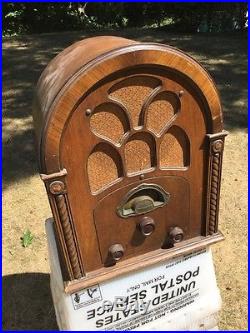
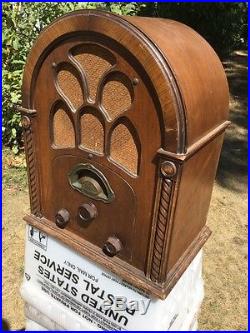
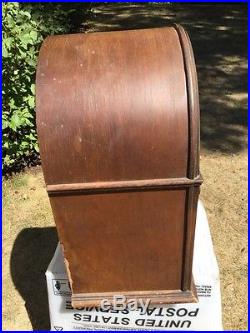
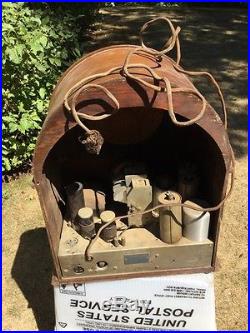
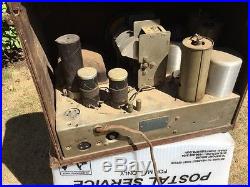
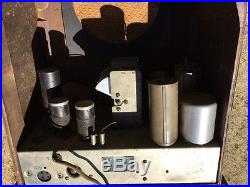
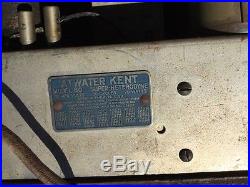
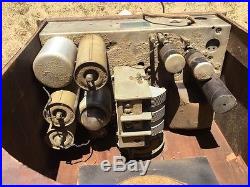
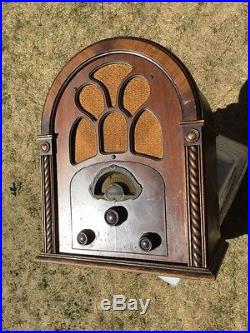
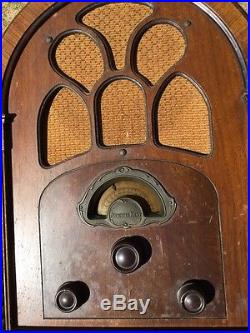
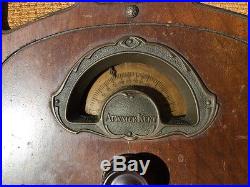
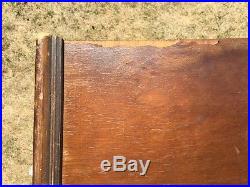
Antique Vintage 1930′s Era Atwater Kent Cathedral Type Wood Case Radio Model 80. Frame measures 18 3/4″ tall, 16″ wide and 10 deep. Has all the original knobs and hardware, the cloth grill looks fine and all the wood filagree is fine with no cracks or chips. The speaker is missing which should be fairly easy to replace, the chassis looks like it might needs tube or 2. The wood frame looks good for the most part; there is 1 back edge that has some veneer edge chipping but just that one edge, the rest look OK with no cracks or chips, there is some normal age wear to the finish. It still has the original cloth covered electrical cord and plug. A great candidate for restoration; much better than just a parts radio in my opinion. Guaranteed all original Atwater Kent. Arthur Atwater Kent, Sr. In 1921, he patented the modern form of the automobile ignition coil. Arthur Kent was born on December 3, 1873, in Burlington, Vermont, to a family of moderate means. The Kent family moved to Worcester, Massachusetts, in 1881, where they lived at four different locations. His father was a doctor who had also been a machinist. The father maintained a machine shop in Worcester when Arthur was a child. Kent entered Worcester Polytechnic Institutes freshman mechanical engineering class in the fall of 1895. He was elected treasurer of the class of 1899, but only remained in the position for one semester, because he did not attend recitation classes after the mid-year exams in January. Kent excelled in mechanics and drawing, but was weak in chemistry, algebra and language, and had no interest in these subjects. He was already running a small business and that was his top priority. The Unisparker Ignition systems became the automobile industry standard for almost 50 years, until the advent of the HEI systems. The same year, he introduced the Model 5, primarily as a promotional tool. In 1923, his firm started producing complete radio sets, using a facility on Stenton Avenue, introducing the Model 10 for Christmas that year. This was followed by the Model 9 “and a broad line of breadboard sets”. This plant, constructed in sections, would eventually cover 32 acres (13 ha). In 1925, the Atwater Kent Manufacturing Company became the largest maker of radios in the United States. The company also sponsored the popular “Atwater Kent Hour”, a top-rated radio concert music program heard on NBC and CBS from 1926 to 1934. The show featured top entertainment and became one of the most popular and acclaimed regular radio programs of the era. At its peak in 1929, the company employed over 12,000 workers manufacturing nearly one million radio sets. The plant itself was an architectural sensation and received hundreds of visitors annually. By 1931, the company boasted that it had produced over three million radios. Atwater Kent radios were of high quality and many examples of working models exist today. They are highly prized by collectors and restorers. Cabinets were made by the Red Lion and Pooley furniture companies for Atwater Kent and exhibited attractive woodworking designs. Some models so closely resembled contemporary furniture that they did not appear to be radios. One example was a radio inside a grandfather clock. The onset of the Great Depression led to greatly diminished demand for Atwater Kent’s expensive radio sets. The company attempted to compensate by building smaller, tabletop radio sets but Kent was not one to compromise on quality. This was compounded by the expiration of patents on the superheterodyne circuitwhich led directly to the proliferation of inexpensive All American Five radio designs. This meant that new firms could easily enter the radio manufacturing market without the same level of capital investment Kent had put into his production process, which relied on heavy metal presses for the relatively large Tuned Radio Frequency (TRF) type radio chassis the firm produced. Kent dissolved his design engineering facility in 1931 and shut down his radio factory in 1936. A major local competitor, Philco, which had branched out into air conditioners and refrigerators, acquired the closed plant and built refrigerators there. In 1937, Kent helped to organize and pay for the restoration of the Betsy Ross House in Center City Philadelphia. In 1938, Kent helped found the Atwater Kent Museum of Philadelphia, Philadelphia’s city history museum, by purchasing the original home of the Franklin Institute on South 7th Street and donating it to the City of Philadelphia. The museum is still operating today and has undergone extensive renovations in the 3 years starting in 2008. Kent’s son-in-law, William L. Van Alen, is the founder of the United States Court Tennis Association. Kent is buried at Forest Lawn Memorial Park, Glendale, California. He was awarded the John Scott Medal of The Franklin Institute in 1914. Atwater Kent was inducted into the Broadcast Pioneers of Philadelphia’s Hall of Fame in 1992. The item “Antique Vintage 1930′s Era Atwater Kent Cathedral Type Wood Case Radio Model 80″ is in sale since Sunday, August 14, 2016. This item is in the category “Collectibles\Radio, Phonograph, TV, Phone\Radios\Tube Radios\Pre-1930″. The seller is “spooknook” and is located in Weymouth, Massachusetts. This item can be shipped worldwide.